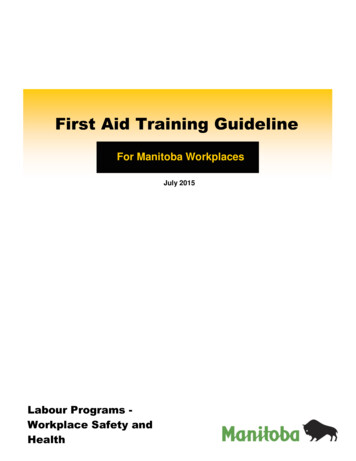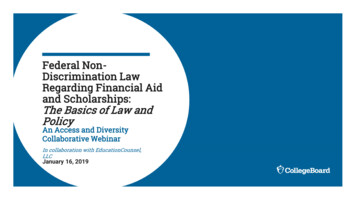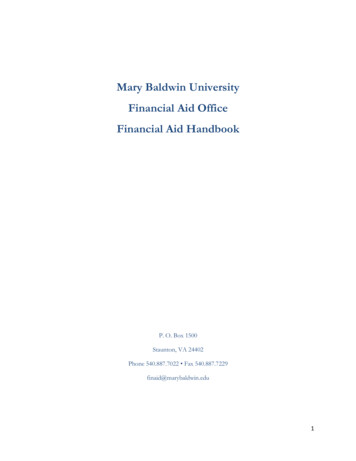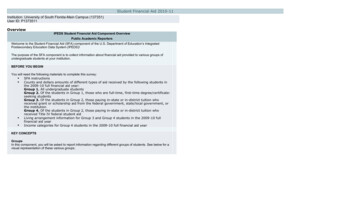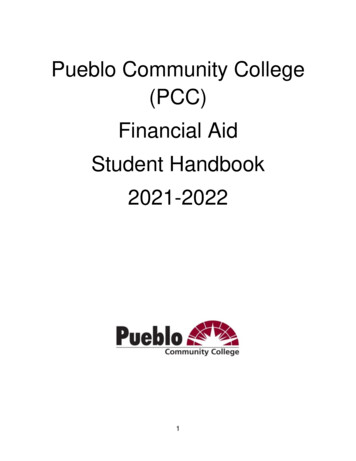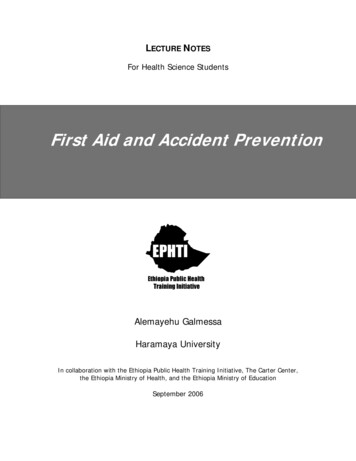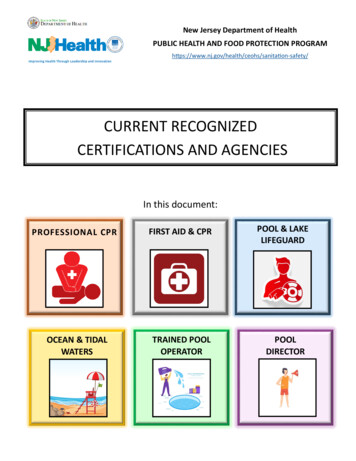
Transcription
A Center Quick Training Aid . . .School-Based Crisis InterventionThis document is a hard copy version of a resource that can be downloaded at no cost from the Center’sWebsite http://smhp.psych.ucla.edu.This Center is co-directed by Howard Adelman and Linda Taylor and operatesunder the auspice of the School Mental Health Project, Dept. of Psychology, UCLA.Center for Mental Health in Schools, Box 951563, Los Angeles, CA 90095-1563(310) 825-3634 Fax: (310) 206-5895; E-mail: smhp@ucla.edu Website: http://smhp.psych.ucla.eduPermission to reproduce this document is granted. Please cite source as the Center for Mental Health in Schools at UCLA.
School-BasedCrisis InterventionPeriodically, windows of opportunities arise for providing inservice atschools about mental health and psychosocial concerns. When suchopportunities appear, it may be helpful to access one or more of ourCenter's Quick Training Aids.Each of these offers a brief set of resources to guide those providing aninservice session. (They also are a form of quick self-tutorial.)Most encompass key talking points for a short training session a brief overview of the topic facts sheets tools a sampling of other related information and resourcesIn compiling resource material, the Center tries to identify those thatrepresent "best practice" standards. If you know of better material,please let us know so that we can make improvements.As an alternative to a hard copy, this set of training aids was designed for free onlineaccess and interactive learning. It can be used online and/or downloaded at(http://smhp.psych.ucla.edu) – go to “Search and Quick Find” and under Quick Find scrolldown the list of “Center Responses” to Crisis Prevention and Response. Also see ourResource Aid Packet for in-depth follow up. Besides this Quick Training Aid, you also willfind a wealth of other resources on this topic. If you would still like to request a hard copy,please feel free to contact us at 310/ 825-3634 or smhp@ucla.edu.1
Guide for Suggested Talking PointsI. Brief OverviewA. Present main points from:School-Based Crisis Intervention - Excerpted from A Center resource packet entitled:Responding to Crisis at a School, (pg. 5.)1.Highlight the range of potential crisis situations and emotional responses thatrequire advance preparation in order to handle (first paragraph). The secondparagraph follows up with potential school problems that can be avoided throughsuccessful crisis intervention.2.The definition of school-based crisis intervention as used by our Center is outlinedin the third paragraph. Providing a clear definition at the outset can help preparethe audience for the goals and expectations of those who will have a role in schoolcrisis management.I. Fact SheetsA. Major Facets of Crises Response- Excerpted from A Center resource packet entitled:Responding to Crisis at a School, (pg. 20).1.A major distinction to point out is the different requirements for local (e.g. oncampus) vs. global (e.g. city or national) crisis. For instance, the first part of crisisresponse ("During the emergency") applies more to local, school-based crisesthan to national crises such as the September 11th terrorism. On the other hand,the final category ("Prevention") is always applicable because it facilitates otherfacets of crisis response.2.Highlighting specific details that are more applicable to your audience for eachcategory will be helpful in generating ideas for a crisis intervention plan. For themost relevant facets of crisis response you might discuss who would coordinate,what community resources you should establish relationships with, where referralsmight be made, etc.3.Also highlight that some facets of crisis response involve providing services for staffas well as students. Aside from providing for the health, safety, and well-being ofstudents, some staff members might require crisis intervention for themselves especially in a local crisis.- Excerpted from A CenterB. Responding to Crises: A Few General Principlesresource packet entitled: Responding to Crisis at a School, (pg. 21).1.This one-page reference provides more specific guidelines for crisis interventionand would make an excellent handout.2.Reinforce the "take home points" (in bold italics). The bullet points that follow eachmajor point provide specific strategies for trying to achieve the major goals. Duringa crisis though, team members might not be able to recall details. Focusing on theoverall goals will improve the chances that the most important ideas from this partof the presentation are easily recalled during a crisis.2
I. Tools/Handouts to Organize a Crisis Response TeamA. Example of Meeting Invitation - Excerpted from A Center resource packet entitled:Responding to Crisis at a School, (pg. 47).1.This sample invitation is provided for your reference. It is provided in Rich TextFormat (rtf) so that you can edit it in your word processor to generate a memo orinvitation for your presentation/meeting.2.Note: The third paragraph mentions "attached material". Having a few keyattachments might help participants be more informed and able to contribute to asuccessful planning session. You might also ask them to write down thoughts,ideas, or suggestions before the meeting and bring them in for discussion.However, you should be prepared to lead the discussion if necessary (becausesometimes even staff do not complete the homework assignment).B. Crisis-Response Checklist- Excerpted from A Center resource packet entitled:Responding to Crisis at a School, (pgs. 22-23).1.This short (2-pg) document can be used as a handout, and/or be included as anattachment to the meeting invitation. It is presented in the form of a checklist to beused in the event of a crisis. However, it can also be used to map your resourcesand decide what areas of your plan have been addressed or need further work.2.In particular, highlight the section on coordinators for different facets of crisisresponse (in "Immediate Response"). These coordinators might also oversee thedevelopment of relevant aspects of your crisis plan. It might be helpful to draw onthe strengths of staff members who already have knowledge that will facilitate theirrole (i.e., the School Nurse might be best for first aid, whereas the staff whocurrently coordinate school-wide assemblies might be best for crowdmanagement).C. Worksheet: Team Membership, Roles, and Functions- Excerpted from A Centerresource packet entitled: Responding to Crisis at a School, (pg. 49).1.This worksheet can be included as an attachment to the invitation along withinstructions for nomination or self-nomination for various roles. Then final decisionscan be made by consensus during the meeting.2.Alternatively, as the meeting organizer, you might use this worksheet solely duringthe meeting to help organize your crisis team plans.I. Tools/Handouts for Crisis RespondersA. Psychological First Aid: Responding to a Student in Crisis - Excerpted from ACenter resource packet entitled: Responding to Crisis at a School, (pg. 31).1.Note: Although the title refers to responding to students, most (if not all) of theprinciples apply to responding to fellow staff members as well.2.This might make an informative handout, especially for those team membersresponsible for direct student or staff support in a crisis. This information should atleast be provided to the coordinator for First Aid/Health.3
3.Again, highlight the most important goals listed in bold italics. These are the keymessages, and subsequent bullet points provide more specific strategies to reachthose goals.B. A Crisis Screening Interview - Excerpted from A Center resource packet entitled:Responding to Crisis at a School, (pgs. 32-34).1.This is a sample interview form and is being provided in Rich Text Format (rtf) sothat it can be easily modified (with a Word Processor) for use by yourhealth/screening staff.2.The screening interview covers factual information that can help with assessingboth the crisis situation and the impact on the student/staff. It also provides aquick screening for acute reactions that might require additional help or referral.I. Additional Resources(printer-friendly format)A. Quick Find on Crisis Prevention and ResponseTo view the web-based quick find on Crisis Prevention and Response, click here.This material provided by:UCLA Center for Mental Health in Schools/Los Angeles, CA 90095-1563(310) 825-3634/ Fax: (310) 206-8716/ Email: smhp@ucla.eduNote: Documents in PDF format ( identified with a ) requireAdobe Reader 3.0 or higher to view. If you don't have thisprogram, you can download it for free from Adobe.4
School-Based Crisis Intervention:Brief OverviewThis Quick Training Aid was excerpted from a Resource Aid Packet entitled: Responding toCrisis at a School, pp. 5. Center for Mental Health in Schools (2000).SCHOOL-BASED CRISIS INTERVENTIONCrises are dangerous opportunities.Chinese sayingCrisis, emergency, disaster, catastrophe, tragedy, trauma -- all are wordsheard too frequently at schools today. Almost every school has had a majorcrisis; every school is likely to have one. Besides natural disasters such asearthquakes and fires, students experience violence and death related to thesuicide of friends, gang activity, snipers, hostage-taking, and rape. Somestudents react with severe emotional responses -- fear, grief, post traumaticstress syndrome. Moreover, such experiences and other events that threatentheir sense of worth and well-being can produce the type of intense personalturmoil that leads students to think about hurting themselves or others.If no effort is made to intervene, emotional reactions may interferewith a student's school and home performance, can be imminentlylife threatening, or may be the start of long-term psychosocialproblems. And, when a significant portion of the student body isaffected, major facets of a school's functioning are likely to bejeopardized.As used here, the term, school-based crisis intervention, refers to a range ofresponses schools can plan and implement in response to crisis events andreactions. All school-based and school-linked staff can play an importantrole in crisis intervention.For more from this Resource Aid Packet ckets.htm
This Quick Training Aid was excerpted from a Resource Aid Packet entitled: Responding to Crisisat a School. pp. 20. Center for Mental Health in Schools (2000).Major Facets of Crises ResponseDuring the emergency communication - sounding the alarm if necessary; clarifying additional steps and providinginformation about the event, location of first aid stations if needed, etc.; rumor control; dealingwith the media; keeping track of students and staff; responding to parents; interfacing with restof the district and community direction and coordination - running an emergency operations center; monitoring problems;problem solving health and safety - mitigating hazards to protect students and staff; providing them withmedical and psychological first aid; providing for search and rescue, security, evacuationImmediate aftermath communication - clarifying causes and impact and debunking rumors; providinginformation about available resources for medical and psychological help direction and coordination - determining need to maintain emergency operations center;continuing to monitor problems and problem solve health and safety - continuing with activities initiated during the eventDays/weeks following communication - providing closure to students, staff, parents, district, community direction and coordination - continuing to monitor problems and problem solve health and safety - providing for those in need of longer-term treatment either throughprovision of direct services or referral; case managementPrevention communication - holding debriefing meetings to clarify deficiencies in response to thecrisis direction and coordination - using debriefing analyses to plan ways to prevent, if feasible,similar events from occurring, to minimize the impact of unavoidable events, to improvecrisis response procedures, to enhance resources health and safety - providing education for students, staff, parents6
This Quick Training Aid was excerpted from a Resource Aid Packet entitled: Responding toCrisis at a School, pp. 21. Center for Mental Health in Schools (2000).Responding to Crises: A Few General PrinciplesImmediate Response -- Focused on Restoring EquilibriumIn responding:C Be calm, direct, informative, authoritative, nurturing, and problem-solving oriented.C Counter denial, by encouraging students to deal with facts of the event; give accurateinformation and explanations of what happened and what to expect -- never give unrealisticor false assurances.C Talk with students about their emotional reactions and encourage them to deal with suchreactions as another facet of countering denial and other defenses that interfere withrestoring equilibrium.C Convey a sense hope and positive expectation -- that while crises change things, there areways to deal with the impact.Move the Student from Victim to ActorC Plan with the student promising, realistic, and appropriate actions they will pursue when theyleave you.C Build on coping strategies the student has displayed.C If feasible, involve the student in assisting with efforts to restore equilibrium.Connect the Student with Immediate Social SupportC Peer buddies, other staff, family -- to provide immediate support, guidance, and other formsof immediate assistance.Take Care of the CaretakersC Be certain that support systems are in place for staff in generalC Be certain that support (debriefing) systems are in place for all crisis response personnel.Provide for Aftermath InterventionsC Be certain that individuals needing follow-up assistance receive it.
Example of Meeting Invitation –This Quick Training Aid was excerpted from a Resource Aid Packet entitled: Responding to Crisis at aSchool, pp. 47. Center for Mental Health in Schools (2000).Meeting to Organizethe School's Crisis Response TeamDateTo:From:As you know the school has decided to (re)organize a school-based crisis team. You have beenidentified as a key person to talk with about the team.At the meeting, we will review the site's existing crisis response plans and discuss a variety of relatedmatters. By the end of the meeting, we will clarify crisis team membership, roles, and initial trainingdates.In preparation for our meeting, please review the attached material.The meeting is scheduled for (date, day, time)To help make the meeting run smoothly and productively, the following staff have agreed to guide theprocess.Meeting facilitator will beMeeting time keeper will beMeeting scribe will beFinally, since a crisis demands that we work quickly, teamwork under pressure will be good practice.This means starting and ending the meeting on time and setting time limits for each task.8
Crisis Response ChecklistThis Quick Training Aid was excerpted from a Resource Aid Packet entitled: Responding toCrisis at a School, pp. 22-23. Center for Mental Health in Schools (2000).In the midst of a crisis, it is hard to remember all the specific steps and preparatory plans that have beendiscussed. Each site and each person responsible for crisis response needs to have a checklist thatprovides a ready and visible reference guide for use during a crisis. Such a checklist is also animportant training tool. The following is an outline of what such a checklist might cover.I. Immediate ResponseCheck to be certain thatappropriate "alarms' have been soundedall persons with a crisis role are mobilized and informed as to who iscoordinating the response and where the coordination/emergency operationcenter and medical and psychological first aid centers are locatedThis may include coordinators foroverall crisis responsecommunicationsfirst aid (medical, psychological)crowd managementmediatransportationphone trees are activatedteam leader and others clarify whether additional resources should be called in(from the District or community -- such as additional medical and psychologicalassistance, police, fire)all assignments are being carried out (including provisions for classroomcoverage for crisis response team members and for any instances of a staff death)corrective steps are being taken when the response is inadequateall communication needs are addressed by implementing planned means forinformation sharing and rumor control (e.g. Public Address announcements,circulation of written statements, presentations to staff/students/ parents inclasses or in special assemblies);This includes communications withstaffhomestudentsdistrict offices and other schoolscrisis teamcommunitymediafire, police
plans for locating individuals are implemented (e.g., message center, sign-in andsign-out lists for staff and students)specific intervention and referral activity are implemented (e.g., triage, firstaid, search, rescue, security, evacuation, counseling, distribution ofinformation about resources and referral processes -- including teentalk andsuicide prevention lines and interviews to assess need for individual counseling)support and time out breaks for crisis workers are implementedinformal debriefings of crisis workers are done to assess how things are goingand what will be required in the way of follow-up activity.II. Follow-up ActivityIn the aftermath, check to be certain thatcontinuing communication needs are addressed (clarifying causes and impact;debunking rumors, updating facts, providing closure; updating information onavailable resources)if relevant, family contacts are made to learn funeral and memorial servicearrangements, and to determine if there is additional assistance the school canprovide (School-related memorial services for gang members, suicides, etc.are controversial; clear policies should be established in discussing crisisresponse plans.)crisis-related problems continue to be monitored and dealt with (includingcase management of referrals and extended treatment)facets of crisis response that are no longer needed are brought to an appropriateconclusiondebriefing meetings are held (to appreciate all who helped, clarify deficiencies incrisis response, and make revisions for the next time)crisis response plans are revised and resources enhanced for dealing with thenext crisisadditional training is planned and implementedappropriate prevention planning is incorporated (e.g., at least to minimize theimpact of such events)For more from this Resource Aid Packet ckets.htm
WorksheetTeam Membership, Roles, and FunctionsThis Quick Training Aid was excerpted from a Resource Aid entitled: Responding to Crisis at a School, p. 49.Center for Mental Health in Schools (2000).Roles/FunctionsTeam LeaderAdministrative LiaisonStaff LiaisonCommunications LiaisonMedia LiaisonFirst Aid Coordinator(s)medicalpsychologicalCommunications CoordinatorCrowd d.Name(One person may serve morethan one role/function)Chain of Command(Who's in charge? Back-ups?)Contact Information
Psychological First Aid:Responding to a Student in CrisisThis Quick Training Aid was excerpted from a Resource Aid Packet entitled: Responding to aCrisis at a School, p. 31. Center for Mental Health in Schools (2000).Pynoos and Nader (1988)* discuss psychological first aid for use during and in the immediateaftermath of a crisis (providing a detailed outline of steps according to age). Their work helps all ofus think about some general points about responding to a student who is emotionally upset.Psychological first aid for students/staff/parents can be as important as medical aid. The immediateobjective is to help individuals deal with the troubling psychological reactions.(1) Managing the situationA student who is upset can produce a form ofemotional contagion.To counter this, staff must*present a calm, reassuring demeanor,*clarify for classmates and others that the student is upset*if possible indicate why the student is upset (correct rumors and distorted information)*state what can and will be done to help the student.(2) Mobilizing SupportThe student needs support and guidance.Ways in which staff can help are to*try to engage the student in a problem-solving dialogue normalize the reaction as much as feasible facilitate emotional expression (e.g., through use of empathy, warmth, and genuineness) facilitate cognitive understanding by providing information facilitate personal action by the student (e.g., help the individual do something to reduce the emotionalupset and minimize threats to competence, self-determination, and relatedness)*encourage the student's buddies to provide social support*contact the student's home to discuss what's wrong and what to do*refer the student to a specific counseling resource.(3) Following-upOver the following days (sometimes longer), it is important to check on how things are progressing.*Has the student gotten the necessary support and guidance?*Does the student need help in connecting with a referral resource?*Is the student feeling better? If not, what additional support is needed and how can you help makecertain that the student receives it?Another form of "first aid" involves helping needy students and families connect with emergency services. Thisincludes connecting with agencies that can provide emergency food, clothing, housing, transportation, and so forth.Such basic needs constitute major crises for too many students and are fundamental barriers to learning andperforming and even to getting to school.*Pynoos & Nader (1988), Psychological first aid and treatment approach to childrenexposed to community violence. Journal of Traumatic Stress, 1, 445-473.
A Crisis Screening InterviewInterviewerDateNote identified problem:Is the student seeking help?Yes NoIf not, what were the circumstances that brought the student to the interview?Student's Name Age BirthdateSex: M FGradeEthnicityCurrent classPrimary LanguageWe are concerned about how things are going for you. Our talk today will help us to discuss what'sgoing O.K. and what's not going so well. If you want me to keep what we talk about secret, I willdo so -- except for those things that I need to discuss with others in order to help you.In answering, please provide as much details as you can. At times, I will ask you to tell me a bitmore about your thoughts and feelings.1. Where were you when the event occurred? (Directly at the site? nearby? out of the area?)2. What did you see or hear about what happened?3. How are you feeling now?32
4. How well do you know those who were involved?5. Has anything like this happened to you or any of your family before?6. How do you think this will affect you in the days to come? (How will your life be different now?)7. How do you think this will affect your family in the days to come?8. What bothers you the most about what happened?9. Do you think anyone could have done something to prevent it?Who?10. Thinking back on what happened,not at alla littleYes Nomore thana littleveryhow angry do you feel about it?1234how sad do you feel about it?1234how guilty do you feel about it?1234how scared do you feel?123433
11. What changes have there been in your life or routine because of what happened?12. What new problems have you experienced since the event?13. What is your most pressing problem currently?14. Do you think someone should be punished for what happened?Who?15. Is this a matter of getting even or seeking revenge?Who should do the punishing?Yes NoYes No16. What other information do you want regarding what happened?17. Do you think it would help you to talk to someone about how you feel about whathappened?Yes NoWho?How soon?Is this something we should talk about now?18.YesNoWhat is it?What do you usually do when you need help with a personal problem?19. Which friends and who at home can you talk to about this?20. What are you going to do when you leave school today?If you are uncertain, let's talk about what you should do?34
TOPIC: Crisis Prevention and ResponseThe following represents a sample of information to get you started and is not meant to be exhaustive.(Note: Clicking on the following links causes a new window to be opened. To return to this window, close thenewly opened one.)Center Developed Documents, Resources and ToolsArticlesSchool and Community Collaboration to Promote a Safe Learning EnvironmentFact SheetsSchools Helping Students Deal with LossThe School's Role in Addressing Psychological Reactions to LossIntroductory PacketViolence Prevention and Safe SchoolsNewsletterSafe Students/Healthy Schools: A collaborative ProcessOtherResources for Responding to and Coping with Hurricane Related EventsHotline NumbersPractice NotesGrief and LossSuicidal CrisisWhen a Student Seems Dangerous to Self or OthersQuickFindsGrief and BereavementPost-traumatic Stressthe Enabling ComponentQuick Training AidSchool-Based Crisis InterventionResource Aid PacketsResponding to Crisis at a School
Addressing Barriers to Learning: A Set of Surveys to Map What a School Has and What ItNeedsTechnical Assistance SamplerA Sampling of Outcome Findings from Interventions Relevant to Addressing Barriers toLearning:Crisis Teams, Response and Aftermath (PDF Document, 10K)School Environment Changes and School Safety Strategies (PDF Document, 12K)Curriculum Approaches to Preventing Crisis Events (Social and Personal) (PDFDocument, 25K)Technical Aid PacketSchool-Based Consultation, Referral, and Management of CareTools for PracticeTools for Practice: Crisis Assistance and Prevention: A Self-study SurveyTraining TutorialCrisis Assistance and PreventionOther Relevant Documents, Resources, and Tools on the InternetAftermathAfter a Disaster: A Guide for Parents and TeachersThe Child Survivor of Traumatic Stress Electronic NewsletterChild Traumatic Stress (From the National Child Traumatic Stress Network)Creating & Maintaining Healthful Psychosocial Environments in the Aftermath ofDisastersCopingCoping with a disaster or traumatic eventCoping with a traumatic event: Information for the publicCoping With a Traumatic Event – For Health ProfessionalsCoping With Disaster fact sheets (From NMHA)Coping with Emotions after a Disaster, "Stress Response to Traumatic Events"Coping with Traumatic Events (From NIMH)Coping with Traumatic Events (From SAMHSA)"Helping Children After a Disaster" (AACAP)Helping Teenagers With StressFundingFinding Funding: A Guide to Federal Sources for Child Traumatic Stress and OtherTrauma-Focused Initiatives (from the Finance Project)Thinking Broadly: Financing Strategies for Child Traumatic Stress Initiatives (from theFinance Project)Generaln a
After Disaster: What Teens Can DoChildren, Stress and Natural DisastersChildren and the NewsCommunication in a Crisis: Risk Communications Guidelines for Public Officials, 2002(SAMHSA)Communicating with Children about Disasters- The American Academy of PediatricsCrisis Communication Guide & Toolkit (National Education Association)Crisis Intervention Resource Packet- A Guide for School-Based Clinicians (CSMH)"Deadly Lessons: Understanding Lethal School Violence"Disaster Mental Health Primer: Key Principles, Issues and QuestionsDisaster Mental Health for Responders: Key Principles, Issues and QuestionsDisaster Mental Health for States: Key Principles, Issues and Questions"Disaster Handouts and Links"Emergency Mental Health and Traumatic Stress: Tips for Talking About DisastersFederal efforts help state prepare for and respond to psychological consequences, butFEMA's Crisis Counseling program needs improvements (2008)Field Manual for Mental Health and Human Service Workers in Major DisastersHow Safe is Your Child's School?How Schools Can Help Students Recover from Traumatic Experiences (Rand Gulf StatesPolicy Institute)Indicators of School Crime and Safety: 2006Practical School Security: Basic Guidelines for Safe and Secure SchoolSelf-Care Tips for Emergency and Disaster Response WorkersThe Long-term Impact of a Traumatic Event: What to Expect in Your Personal, Family,Work, and Financial LifePsychological First Aid Field Operations Guide (from the NCTSN)Readiness and Emergency Management for Schools Technical Assistance CenterResources for recovery: youth people, service, learning and disasters"The Road to Resilience" helping people in times of hardship (APA)School Safety, Violence and Security Center for Faculty, Educators and AdministratorsSchool-Violence Fact Sheets (a selection of fact sheets on a variety of school violence issues,provided by the Center for the Study and Prevention of Violence)Stress Management for Health Care ProvidersSuggestions for Educators: Meeting the Needs of Students- U.S Department of EducationSurviving Field Stress for First RespondersTraumatic Incident Stress: Information for Emergency Response WorkersHurricaneAfter Katrina: Shared Challenges for Rebuilding Communities (2007) C. De Vita, UrbanInstituteHurricane AwarenessHurricane Awareness WeekHurricane Evacuation ChecklistHurricane Help for SchoolsHurricane-Related DistressRecovery: After a HurricaneTerrorismChildren, Terrorism & DisasterCoping After Terrorism: A Guide for Healing and Recovery (US DOJ)
Maintaining a Healthy State of Mind After a Terrorist EventInfo for Parents & CaregiversInfo for Middle School StudentsInfo for High School StudentsInfo for AdultsInfo for SeniorsMental Health Response To Mass Violence And Terrorism: A Field Guide"Terrorism & Schools: School Terrorism, School Security, Emergency Planning"Teaching Students About Terrorism and Related Resources (PBS Educational Services)Psychosocial implications of disaster or terrorism on children: a guide for the rints for Violence Prevention Overview" (Center for the Study
crisis management. I. Fact Sheets A. Major Facets of Crises Response - Excerpted from A Center resource packet entitled: Responding to Crisis at a School, (pg. 20). 1. A major distinction to point out is the different requirements for local (e.g. on campus) vs. global (e.g. city or national) crisis. For instance, the first part of crisis
